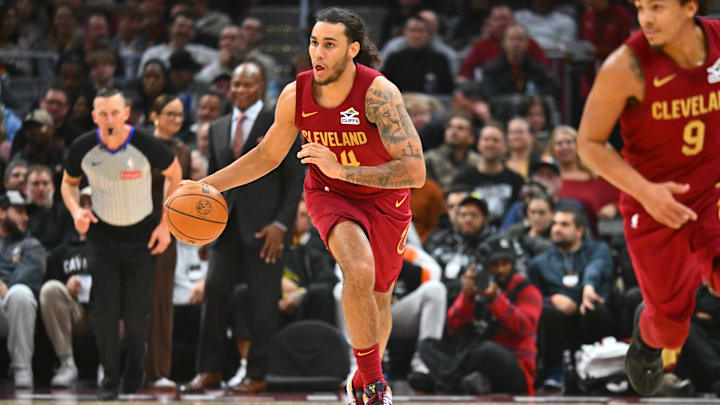This summer, the Cleveland Cavaliers targeted proven veteran depth pieces to complement the starring cast. With Lonzo Ball, Larry Nance, Jr. and Thomas Bryant in town, Cleveland enters the 2025-26 season with answers for some major lingering questions.
Ball, though injury prone, provides the Cavs with a trustworthy backup point guard behind Darius Garland. His tall build and defensive impact also add attributes Cleveland's guard rotation had not enjoyed in years prior. After last season with scoring maestro Ty Jerome leading the second unit, the Cavaliers pivoted in favor of a well-rounded two-way bench leader.
In the frontcourt, Nance and Bryant bring a versatile depth the Cavaliers have needed since drafting Evan Mobley in 2021. Until now, the Cavs had gone through a revolving door of uninspiring backup centers behind Mobley and Jarrett Allen. Robin Lopez's locker room presence was welcome, but his on-court production was underwhelming at best. Tristan Thompson gave physical tenacity, but he was unplayable in the postseason.
All three of the Cavs' newly-acquired veterans can impact winning in the regular season and playoffs. Bryant is off the heels of a Finals run with the Indiana Pacers, and both Ball and Nance have high potential as bench players in the postseason.
Outside of the backcourt and frontcourt, however, the Cavaliers' depth may fall shorter than expected. On the wing, Cleveland has a plethora of choices with De'Andre Hunter, Max Strus, Dean Wade, Sam Merrill, Jaylon Tyson and rookie Tyrese Proctor. Merrill will likely mostly fill backcourt minutes behind Donovan Mitchell, though, taking him out of that pool.
Cleveland's wing depth is lacking after preseason action
In his first full season with the Cavaliers, Hunter is entering a starting role during Strus' injury absence. Behind Hunter, Cleveland's choices are questionable. Even when Strus returns, the Cavs do not employ another reliable big 3-and-D wing other than Hunter. Wade has shown flashes of impactful production, but his lapses in confidence and shooting volume hurts his value in a playoff series.
The young Jaylon Tyson has the physical build and potential to fill that role, but his preseason performances make it unlikely that he is ready to step into that position right away. Tyson's shooting form is still underdeveloped, making him unlikely to help the Cavs space the floor if he is on the court for extended time. His hustle plays for rebounds and selfless attitude show a potential to become a high-end role player in time, but this year may not be his season to reach that ceiling.
With both Merrill and Strus, they are undersized wings who cannot hold back taller forwards on defese. Strus' physical strength has allowed him to play bigger than he is, but the 6-foot-5 wing is not the best option to play behind Hunter with the Cavs' undersized backcourt already a lingering flaw.
Proctor falls into a similar role as Merrill, more suitable as a shooting guard sharpshooter rather than a defensive small forward. Proctor's crafty ball handling and marksman shooting skills may quickly place him into the Cavs' rotation as an injury replacement, but he is far from a backup small forward who can solve Cleveland's problems.
The Cavaliers need another big wing
Last trade deadline, trading for Hunter from the Atlanta Hawks was the Cavaliers' big home run swing of the year, and he will be one of the most important Cavaliers this season. The 6-foot-8 veteran checked every box the Cavs had been searching to find, shooting over 40 percent from three-point range and showing the ability to defend at a high level.
Adding another two-way combo forward like Hunter is a big ask, considering the years it took the Cavaliers to do it the first time. Players of Hunter's archetype come at a premium cost in the NBA. Even teams like the Houston Rockets who have a plethora of big wings hold onto each and every one of them, using their positional versatility to fill out the rotation rather than boxing them into one or two roles.
To add another reliable big wing behind Hunter would require the Cavs to maneuver the salary cap limitations placed on them by the second apron. Cleveland cannot take in extra money or stack salaries to match an expensive player in any trades. This leaves the Cavaliers to search for inexpensive, undervalued players who teams may be ready to deal.
If the Cavaliers hope to swindle a team in the trade market for somebody like Naji Marshall or Julian Champagnie, they will likely have to part with one of their own preexisting wings. Monitoring injuries of those teams could open the pathway for the Cavaliers to offer a replacement talent if one of their rival's best sharpshooting wings goes down for a lengthy period. With Strus and Wade, offering one of them in a trade could present an opposing side with a proven veteran shooter on a team-friendly contract.
Te Cleveland Cavaliers have addressed the majority of their biggest question marks ahead of this season. The upgrades in the guard and center positions leaves the wing the only place left to target for growth. If Tyson's development can accelerate after an okay preseason, the Cavs may already have the answer. Otherwise, a cheap player like Marshall or Champagnie could be exactly what Cleveland needs.
